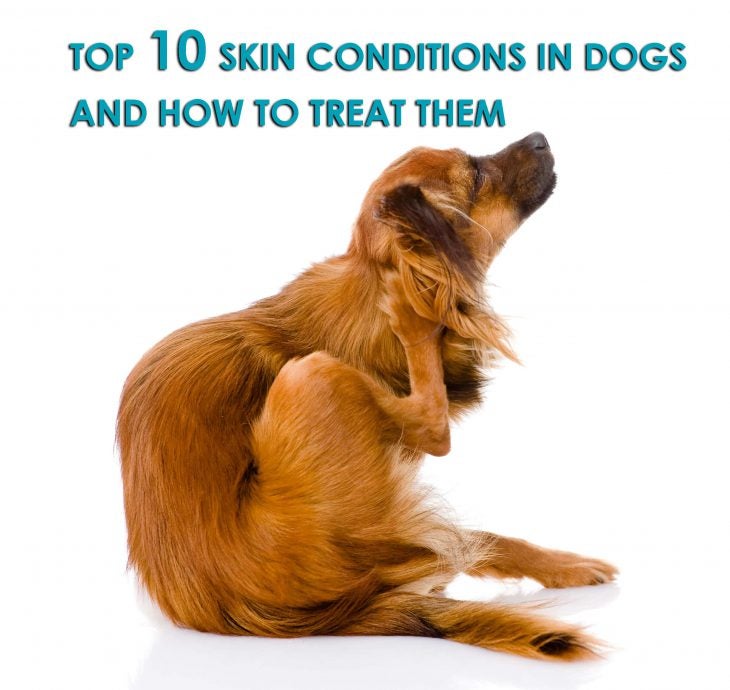Dogs are very susceptible to skin conditions since they usually spend time outdoors and have frequent contact with other pets. While there are many different types of skin conditions that affect dogs, we compiled a list of the most common skin conditions dogs affecting dogs and how to treat them.
- Acral Lick Dermatitis (aka Acral Lick Granuloma) – if your dog is constantly licking a specific part of its body such as the front of its lower legs, it could be suffering from Acral Lick Dermatitis. Relentless licking of the affected area prevents it from healing properly thereby causing pain and itching.
How to Treat: the use of an E-collar, cone collar, or recovery collar can help stop the dog from licking the area. Also, applying a bad-tasting solution to the affected area can dissuade a dog from licking it.
- Allergic Dermatitis – Pollen, insect bites, certain foods and even grooming products can cause some dogs to experience an allergic reaction. Constant scratching and evidence of an ugly rash on your dog’s skin are indicators that it is suffering from an allergic reaction.
How to Treat: The best way to treat allergic reactions in dogs is to identify the allergen and avoid contact with it. To help with itchy rashes, you might want to give your dog a corticosteroid such as Prendisone.
- Anal Sac Disease – Your dog releases a foul-smelling substance when it defecates. This substance comes from small anal sacs which if are not emptied can become impacted. Signs your dog is suffering from anal sac disease are scooting its bottom across the floor and/or licking and biting the anal area.
How to Treat: Full anal sacs are usually manually drained. This procedure should be performed by veterinarian. Surgical removal is necessary in severe cases.
- Fleas – Fleas are so small you can hardly seem them, but they can cause big problems for you and your dog. Signs your dog has fleas are excessive licking, incessant scratching, scabs and hot spots. Anemia due to blood loss and tapeworms are just some of the ailments that can affect a flea infested dog.
How to Treat: Topical or oral flea killers along with cleaning the dog’s sleeping area and yard are the most preferred methods of getting rid of fleas.
- Mange – Tiny parasites called mites are what cause mange. Canine scabies are easily transmitted to from dog to dog. This type of mange will affect a dog’s ears, face and legs. Itching, red skin, sores, and hair loss are indicative of a dog with canine mange. Another type of mage is Demodectic mange can cause bald spots, scabbing, and sores.
How to Treat: Topical medications are used to treat mange.
- Ringworm – is a fungus that forms ring-like lesions usually found on a dog’s head, paws, ears, and forelegs. Inflammation, scaly patches, and hair loss often surround the lesions. Puppies less than a year old are the most susceptible. Ringworms can spread quickly between dogs in a kennel or even to pet owners at home.
How to Treat: Anti-fungal treatments are used to treat ringworms.
- Seborrhea – is a genetic disease that will last throughout a dog’s lifetime. However, some dogs develop seborrhea due to allergies or hormonal issues. Symptoms include greasy skin and dandruff.
How to Treat: Topical treatments and shampoos are used to treat seborrhea.
- Shedding and Hair Loss (Alopecia) – Excessive shedding or hair loss in dogs is symptomatic of stress, poor nutrition, or an underlying illness.
How to Treat: Take your dog to a veterinarian if the hair loss or shedding lasts more than one week.
- Skin Tumors – Dogs can develop cancerous tumors in their skin. A biopsy of the tumor is the only way to determine if a tumor is cancerous. A hard lump on your dog’s skin is indicative of a tumor. Take your dog to a veterinarian right away if see any lumps on its body.
How to Treat: Small lumps can and should be removed as soon as possible.
- Ticks – Are parasites that feed on the blood of their hosts. Ticks can be seen feeding off your dog. Ticks are known to transmit Lyme disease as well as bacterial infections.
How to Treat: You can remove the ticks with tweezers or you can have veterinarian remove them. The use of oral and topical flea & tick medications are great preventatives.
In conclusion, dogs are affects from skin conditions such as acral lick dermatitis, allergic dermatitis, anal sac disease, fleas, mange, ringworm, seborrhea, shedding and hair loss, skin tumors, ticks, and a host of others. Skin conditions in dogs can appear as lesions, sores, lumps, or hair loss. In addition, a dog with a skin condition will excessively scratch, bite, or lick the affected area. If you observe these signs or behaviors in your dog, take it to a veterinarian right away to get an accurate diagnosis. Most treatments involve topical or oral medications. In some cases, a veterinarian may have to perform a procedure.





